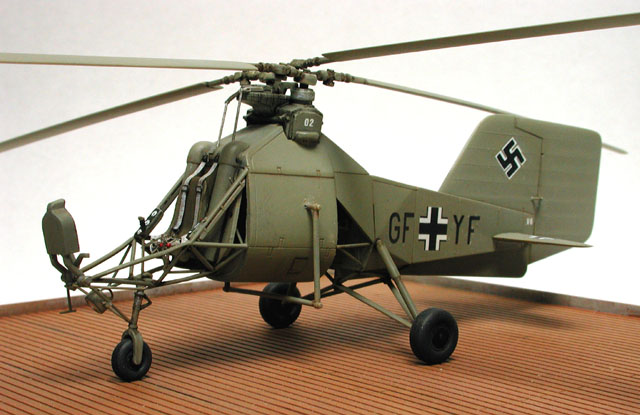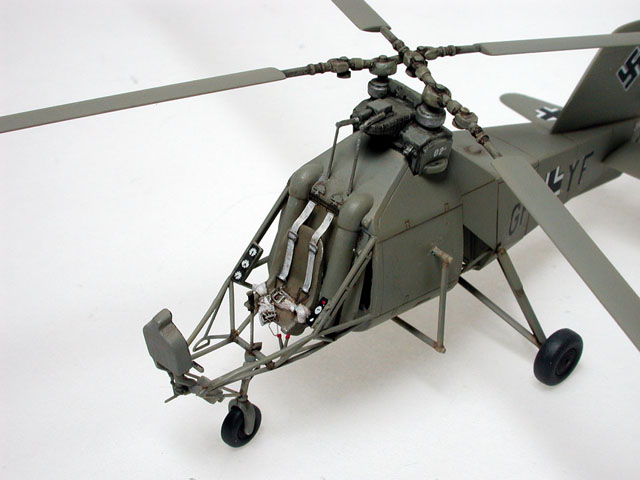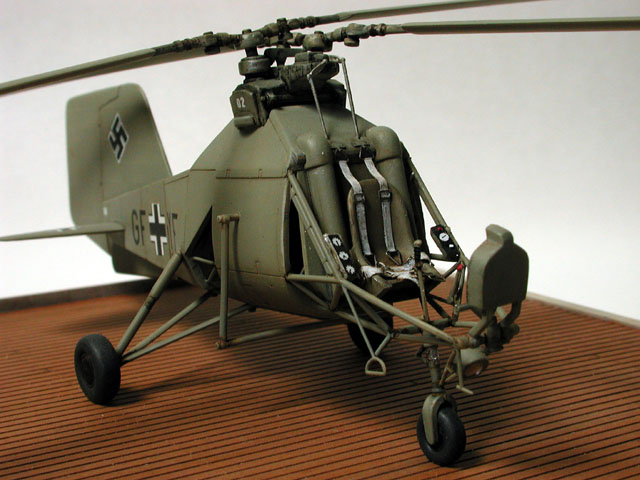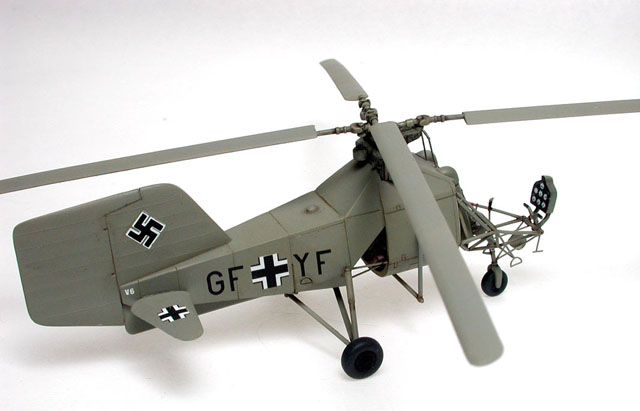|
Flettner Fl 282 "Kolibri"
by Dave Orloff
|
 |
|
Flettner Fl 282 Kolibri |
Images by Milton Bell

Huma's 1/48
scale Flettner Fl 282 "Hummingbird" is available online at
Squadron
As early as the
1920s, German engineers were experimenting with helicopters. One such
visionary was Anton Flettner, whose development of a series of helicopters
intended for naval use began in earnest in 1935 with the opening of his
Berlin-Johannisthal factory.
Flettner’s first
successful design, the Fl-265, was tested aboard ships in 1939, and was
agile enough in trials to outmanoeuvre a pair of Messerschmitt Bf 109
fighters! This was the first successful use of twin intermeshing
counter-rotating rotor blades, but a single seat aft of the transmission
and the engine mounted in the nose combined to make this a less than ideal
type for full service.

In 1940 the Flettner
company produced the first of their Fl-282 “Kolibri” (Hummingbird)
helicopters. A direct development of the earlier Fl-265, the 282 was a
neat little machine, using Anton Flettner’s revolutionary rotor system to
produce a stable helicopter unencumbered by a complex tail rotor
mechanism. Moving the radial engine aft of the pilot put the cockpit up
front in what would become the conventional layout for modern helicopters.
The resulting craft was relatively easy to fly, extremely maneuverable,
and mechanically reliable. Though 1000 were ordered, only 24 were
delivered over the course of the war, and served as shipboard scouts and
landbased battlefield spotters from 1940 right up through the Battle of
Berlin in 1945.
|
Huma's 1/48 Scale Flettner Fl 282 |
Huma’s kit is their
only 1/48 scale offering so far, consisting of 75 well molded styrene
parts on two trees and decals for two machines. Parts are provided to
build both one and two seat versions, with or without auxiliary fuel
tanks. Also provided is a spotlight and the unusual trapeze-like bar used
to carry sling loads. All scribing is engraved and very crisp. On opening
the box I was immediately surprised by the quality of the parts, and the
delicacy of molding. I honestly believe I have never seen so many tiny
structures produced in plastic as are found in this kit! The engine alone
builds up out of 15 individual components, and lacks only plug wires to be
complete right from of the box. What a shame that it is all but invisible
inside the fuselage! The many representations of tubular framing are well
done, with only slight mold parting lines to clean up. A little patience
and a fresh No 11 blade pay off big time here! Huma’s plastic is soft
enough to allow for some flex in the small parts, a good thing as even the
fuel lines for the engine are included and require a bit of bending to
match the instructions.
The instructions are
adequate, though some steps require careful study of the exploded views
provided. No assembly text is included, so reference to photos of the
prototype and careful test fitting are required to get the cockpit and
landing gear right.
My only fit problem
was along the fuselage top aft of the rotor assembly. The right fuselage
half on my example was rather warped, but careful bending and a spot of
putty smoothed things out nicely. Care is also needed when capturing the
engine between the fuselage halves. The only weakness so far as detail is
the instrument panel and side consoles. There are no molded instruments,
just decals affixed to featureless faces. This would be easy enough to
enhance with PE aftermarket bezels.

I added a set of
Eduard harnesses and an extra support for the foot step and was well
pleased with the overall look of the cockpit. No problems here with hidden
detail, it’s right out there for all to see. The landing gear is somehow
sturdy without losing the delicate appearance of the original. As a bonus,
my model required no additional nose weight to keep all three wheels where
they belong, a good thing as there is precious little space to add
anything inside.
I elected to build
the naval version, a single-seat model without the twin external fuel
tanks. Several photos of the helicopter represented are in Heinz Nowarra’s
book, depicting operations from aboard a ship at sea in the Baltic or
Mediterranean. I used Aeromaster RLM 63 acrylic paint overall, with
various Testor’s enamels for detail. The decals went on well over a couple
of coats of Future, the model also was washed with Windsor & Newton Burnt
Umber and Black oil paints thinned with mineral spirits. As usual with
European kits, the swastikas had to be scavenged from the scrap pile,
though for the adventurous Huma does include two odd outline squares with
a black cross inside that could be meticulously cut into swastikas. A few
light coats of Polly Scale clear flat and the little Hummingbird looks
ready to fly!
As a display base, I
cobbled together a Helipad from Plastruct odds and ends to represent the 5
meter square decks built atop turrets on the Corvettes and Destroyers that
operated these fascinating machines. I could find very little precise
detail, so this is a “best guess” based on a few fuzzy photos. The
structure is painted a well weathered light grey, with the wood decking
painted Model Master wood tan with washes of Burnt Umber and Black oils to
bring out the scribed detail, and pastels used to “rust” the frame.

In conclusion, Huma
has created a beautiful kit of a very obscure but significant WWII
aircraft. With a little extra care and a lot of patience with the tiny
parts a unique bit of history can occupy a space on your shelf, too.
Reference
Added Detail
Click the thumbnails below
to view larger images:
Text and Model Copyright © 2001 by Dave Orloff
Images Copyright © 2001 by Milton Bell
Page Created 10 December, 2001
Last Updated
04 June, 2007
Back to HyperScale Main Page
Back to Features Index |
Home
| What's New |
Features |
Gallery |
Reviews |
Reference |
Forum |
Search